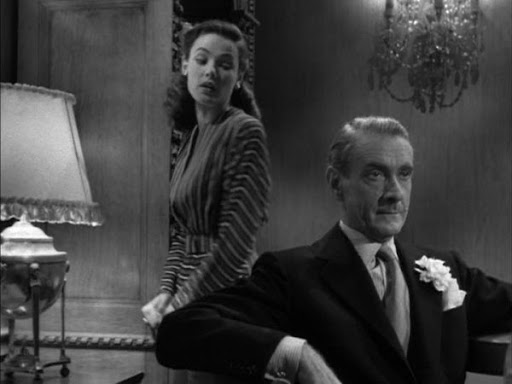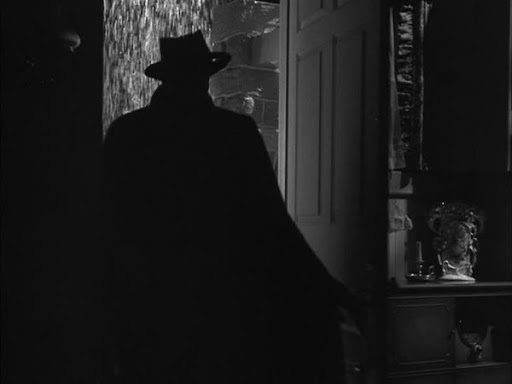
Laura is one of those films where I'm so busy studying shadows that I forget there's a movie lurking about. The cinematography, set design, and lighting of this film are masterful. Preminger is masterful. I could get lost in the intricacies of a wall or the cast of Dana Andrews' overcoat and pantlegs as he moves through a room. The story isn't what makes Laura a masterpiece, it's the care that was taken in making the film. Few directors in our era (Wong Kar-wai and Tetsuya Nakashima being two exceptions) take the painstaking time that Preminger and his crew took in making Laura. I, for one, am thankful that he was a perfectionist.
And then there's Jean Tierney. Damn. She's absolutely beautiful. Enjoy!

From A. Pillai at Film Reference:
" Laura is Preminger's Citizen Kane , at least in the sense that Otto's detractors, like Orson's [Welles] have never permitted him to live it down," comments Andrew Sarris in his essay, "Preminger's Two Periods."
The film, which is based on Vera Caspary's very popular book of the same name, was brought to Darryl F. Zanuck's attention by Otto Preminger. Although Preminger was allowed to produce it, Zanuck insisted that someone else be brought in to direct it. Rouben Mamoulian was subsequently brought into the project. However problems with the initial shooting and characterization in the film led to Mamoulian's removal as director, and subsequent replacement by Preminger.
Although Preminger claims to have reshot all of Mamoulian's earlier work, the latter states that three-quarters of the released version of Laura was part of his original footage—a fact that his cameraman, Lucien Ballard confirms. However, Preminger confided to Joseph La Shelle, who replaced Ballard as cameraman, that "We're not going to leave any scene at all of Mamoulian's in this picture."
Despite these problems and the tension that existed between cast and director when Preminger took over and characters in the script were reassessed and changed, Laura to everyone's surprise became a blinding success. However, the author Vera Caspary had great problems with the film's script not least of which was the use of a clock as the hiding place for the murder weapon. In Caspary's book the gun is hidden in Waldo Lydecker's cane. The author argued that this symbolized the murderer's impotence; Preminger contested that the audience would not understand this Freudian idea.

Essentially a crime story, Laura centers around the murder of a woman, who has been shot in the face, and the effect that it has on the people around her. The investigating detective brought in to solve the case, Mark McPherson (Dana Andrews) is a hard-boiled policeman—a far cry from the "highly intelligent criminologist" Andrews originally envisaged. McPherson sees a portrait of the alleged murder victim and falls in love with her. In a highly charged, very sexual scene McPherson wanders around Laura's apartment, touching her possessions, loosening his tie, and clutching a drink, as he stares moodily at the portrait. He dozes off fixating on Laura, and awakens to find the object of his passion standing before him. Lydecker (Clifton Webb) recognizes this strange fixation and says: "You'll end up in a psycho ward. I don't think they've ever had a patient who fell in love with a corpse."
Waldo Lydecker, the highly intellectual news columnist, tells McPherson about Laura. She approached Lydecker while he was having lunch at the Algonquin, and asked him to endorse a pen. Although he refused, he could not get Laura out of his mind and tracked her down. Taking her under his wing, Lydecker groomed her introducing her to important people. However, while Waldo fulfilled an emotional and intellectual need, Laura looked to other men for relationships. For the most part these men were meaningless until she met the debonair but spineless Shelby Carpenter (Vincent Price), and became engaged to him. Just before her murder Lydecker told Laura that her fiancé was having an affair with a young model, Diane Redfern. Laura went away to think about their relationship.
McPherson embarks on a determined quest to find the identities of the real victim and the murderer. Piecing events together he works out that the victim is Diane Redfern. Shelby reluctantly admits that he met Diane at Laura's flat. When the doorbell rang, Diane answered it and was shot in the face by her killer. Shelby panicked and left; he confesses that he thought that Laura was the murderer.

McPherson, suspicious of Lydecker goes to his flat and searches it. He finds a baroque clock identical to one in Laura's flat. Searching Laura's clock he finds the murder weapon concealed within it. He leaves to arrest Lydecker, not realizing that Lydecker is incensed that Laura is in love with McPherson, and has returned to try and kill Laura again. Luckily McPherson rescues her in time.
The male characters in Laura are interesting. They present different aspects of masculinity, and are all in a sense symbols of impotency. Shelby is a weak, amoral man who uses Laura for his own ends but does not really see or desire her as a woman; Lydecker is the cynical, witty friend who can never be a lover but idealizes her; and McPherson is a masculine, brawny man, who illustrates his impotency by falling in love with a dead woman. As the hero he, however, moves beyond this point into a new realm with his dream woman.
Laura does not physically enter the story until about half way through the film when her persona has already been set up. The audience is aware that she is a beautiful, intelligent, and sensual woman. Her world is one of rich, sophisticated people. She is set up on a pedestal well before she appears on screen. However in reality Gene Tierney's Laura is an ambitious woman—a woman who knows her mind, who states "I'll never do anything that isn't of my own free will."
The whole of the film has a dream-like feel to it. This was mostly due to La Shelle's camera work. He reportedly took hours to set up each scene, fiddling over lighting. The film contains many long shots in which the camera pans the landscape—the shot of Lydecker's apartment, which is based on an unused scene in Hitchcock's Rebecca , is an example of this. The end result well justified the time and deliberation that went into planning these shots as the film won an Academy Award for Best Cinematography in 1944.

Technical Information:
Title: Laura
Year: 1944
Country: USA
Director: Otto Preminger
Source: DVD9 Retail
DVD Format: NTSC
Container: .iso + mds
Size: 7.44 GB
Length: 1:27:02
Programs used: ImgBurn
Resolution: 720x480
Aspect Ratio: 4:3
Video: MPEG2 @ ~6500 kb/s
Frame Rate: 29.97 fps
Audio 1: English- Dolby AC3 Stereo @ 192 kb/s
Audio 2: English- Dolby AC3 Mono @ 192 kb/s
Audio 3: Spanish- Dolby AC3 Mono @ 192 kb/s
Audio 4: English Commentary- Dolby AC3 Stereo @ 192 kb/s
Audio 5: English Commentary- Dolby AC3 Stereo @ 192 kb/s
Subtitles: English, Spanish, cc-English, cc-Spanish
Menu: Yes
Video: Untouched
DVD Extras:
- Commentary by David Raksin and Jeanine Basinger (theatrical version only)
- Commentary by Rudy Behlmer (theatrical version Only)
- "Biography Gene Tierney: A Shattered Portrait"
- "Biography Vincent Price: The Versatile Villain"
- Deleted Scene
- Theatrical Trailer
- Extended Version

(Use JDownloader to automate downloading)
Laura Megaupload Links



